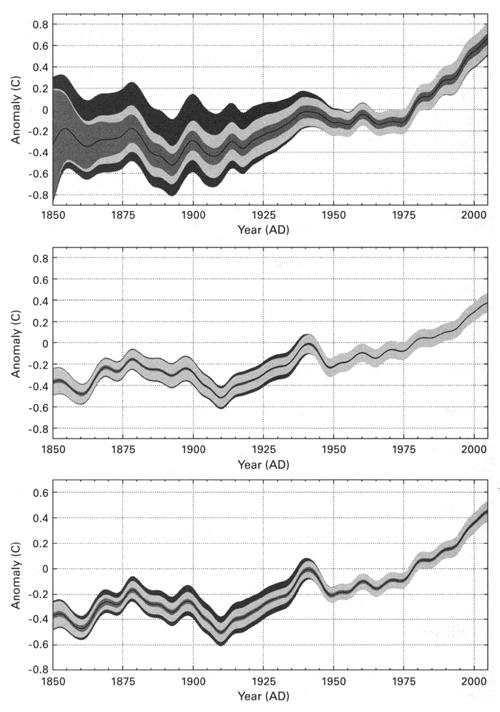
This Article From Issue
July-August 2010
Volume 98, Number 4
Page 336
DOI: 10.1511/2010.85.336
A VAST MACHINE: Computer Models, Climate Data, and the Politics of Global Warming. Paul N. Edwards. xxviii + 518 pp. The MIT Press, 2010. $32.95.
In recent months, two events have cast doubt on the “climate change consensus.” In November 2009, it was revealed that senior scientists in the University of East Anglia’s Climatic Research Unit (CRU) had been withholding information concerning their working methods and data sources. In the new year, the United Nations Intergovernmental Panel on Climate Change (IPCC) was forced to concede that a claim about Himalayan glacier melting—made in its 2007 scientific assessment report—was false. These events, according to some climate-change skeptics, are evidence of scientific misconduct and further proof that the current epistemological consensus rests on shaky factual foundations. Although the CRU has now been cleared of any wrongdoing and IPCC Chair Rajendra Pachauri has defended the Panel’s scientific conclusions robustly, “Glaciergate” and “Climategate” seem to have affected public belief in the reality of anthropogenic climate change—if several recent opinion polls in the United Kingdom and the United States are to be believed.
Paul N. Edwards, a professor in the School of Information at the University of Michigan, could scarcely have imagined that his new book would be published in this highly charged context. The fact that it has been emphasizes just how important the messages contained in A Vast Machine are. As I will explain, Edwards’s remarkable monograph, by looking under the hood of both meteorology and climatology, shows us why we ought to be skeptical about the claims of the climate-change skeptics.
In philosophical terms, Edwards’s focus is epistemological rather than ontological. He explores how we have come to know weather and climate, beginning his inquiry with events from well over a century ago. As with all nonlaboratory science, the challenge of describing—let alone explaining or predicting—the behavior of large and dynamic biophysical systems is formidable. As Edwards rightly says, “You can’t study global systems experimentally; they are too huge and complex.” Considerable effort, ingenuity and informed guesswork are thus required to make credible sense of weather and climate. In the prescient words of English critic John Ruskin (writing in 1839), a “vast machine” must be constructed, one made up of interlocking systems of data measurement, data sharing, data analysis, data checking, data smoothing, process simulation and predictive modeling. One hundred and seventy-one years on, Ruskin’s metaphor has been made flesh: Today, we have a truly global, resource-intensive and highly complex infrastructure devoted to understanding weather and climate. It is serviced by diverse and specialized epistemic communities (climate modelers and Quaternary scientists, for example), whose knowledge is routinely shared and synthesized in order to make sense of short-term weather patterns and longer-term climatic trends. Edwards describes and explains how the “vast machine” evolved.
Clearly, this is an enormous undertaking. I can think of no other book that relates in such detail how meteorological and climatological science came into existence, sometimes acting as separate bodies of knowledge but increasingly interlocking in recent years. Over the past decade, Edwards has spent huge amounts of time exploring diverse archives and conversing with numerous practicing scientists. A Vast Machine is organized more or less chronologically; its focus is, for the most part, the English-speaking world. The first chapter gives an overview of the book’s framework and argument. Chapters 2 through 5 describe weather forecasting and climatology in their infancy, prior to 1945. The next two chapters deal with weather prediction and climate modeling between 1945 and 1970. Chapters 8 through 10 relate how a weather information infrastructure was built between 1945 and 1980. These are followed by two chapters that describe how, since 1980, meteorology has been worked back into climatology. The concluding three chapters take us up to the present, showing how climate-change science has informed public policy since the first United Nations Earth Summit of 1992 and how the science has been politicized, especially in the United States.
Edwards’s is a history with a point, as he makes clear on the very first page:
In the countless political controversies over climate change, the debate often shakes out into a contest: models versus data.
This supposed contest is at best an illusion, at worst a deliberate deception—because without models, there are no data. I’m not talking about the difference between “raw” and “cooked” data. I mean this literally. [emphasis in original]

Edwards is here challenging the simplistic idea that model predictions about climate change and its impact are separate from the putative “raw data”—measurements of temperature, precipitation, albedo and other factors. This idea is implicit in the recent criticisms of both the CRU and the IPCC, just as it was in the hearings on “Scientific Integrity and Public Trust” that were held in 1995 by the U.S. House of Representatives Subcommittee on Energy and Environment and chaired by Dana Rohrabacher. Its persistence is worrying, because it misrepresents how the sciences of weather and climate operate.
As Edwards shows, the past and present “data” about our atmosphere are patchy, incomplete and open to interpretation. Just as important, the data have never spoken for themselves: They have always been made meaningful by way of computer models. Everything we know about the global climate, says Edwards, comes from simulation models (which are based on physical theory), reanalysis models (which come from weather forecasting and constrain their results with actual observations) and data analysis models (mathematical techniques used to process historical records of weather and climate). Edwards’s point is not that the data are “made up”; as I’ve intimated, he is not a climate-change skeptic bent on discrediting the science because it is not scientific enough. His aim is to challenge the unrealistic ideal of “sound science” that many skeptics hold dear, because this ideal seeks to downplay the “craft” dimensions of science and presumes that the only evidence that counts is “definitive evidence” (which is taken to be an “objective” confirmation of scientists’ otherwise “subjective” hypothesizing). To accept that meteorology and climatology are, like all sciences, domains of human practice inhabited by fallible agents (and thus amenable to a sociological analysis) does not imply that they are fundamentally flawed or that the knowledge they produce is intrinsically unreliable.
The first chapter flags this point by listing several core concepts that appear in the book, all of which speak to the sheer difficulty of constructing robust knowledge both of weather patterns and of climate trends—past, present and future. For instance, Edwards uses the phrase “data friction” to describe those many situations in which atmospheric information gathered for a particular purpose in one place and time must be somehow made useful at a later point in history by others who have quite different needs. Overcoming the friction is no mean feat, but it has to be done—past data are a valuable resource (whatever their limitations might be). The various stories that Edwards recounts—about Vilhelm Bjerknes building an influential meteorological institute in Bergen, Norway, for instance, or John von Neumann championing computerized weather prediction models after World War II—all testify to the almost heroic efforts made over the past century or so by tens of thousands of people worldwide to render weather and climate intelligible.
Who should read this book? Edwards casts his net wide. A Vast Machine is sufficiently readable to appeal to those unfamiliar with the two sciences it describes, but it is also technical enough to interest specialists. Although Edwards’s background is in what’s sometimes called “social studies of science and technology,” he is careful to distance himself from the perceived antiscience bias for which physicist Alan Sokal (in)famously attacked the field in the 1990s. This is not a political tome masquerading as a history-of-knowledge production. Edwards has produced a well-researched and scholarly monograph that will, I suspect, remain definitive for many years to come. It is very well written and presented attractively. And one can read the book selectively, according to one’s interests, after digesting the introduction and first chapter. In some ways, the best place to begin is in the present, with the final two chapters. The reader can then work back from there in order to understand why atmospheric science is so robust today rather than being (as the skeptics would have it) a house built on sand.
I recommend this book with considerable enthusiasm. Although it’s a term reviewers have made into a cliché, I think A Vast Machine is nothing less than a tour de force. It is the most complete and balanced description we have of two sciences whose results and recommendations will, in the years ahead, be ever more intertwined with the decisions of political leaders and the fate of the human species.
Noel Castree is a professor of geography in the School of Environment and Development at Manchester University, England. His principal research interest is in the political economy of environmental change.

American Scientist Comments and Discussion
To discuss our articles or comment on them, please share them and tag American Scientist on social media platforms. Here are links to our profiles on Twitter, Facebook, and LinkedIn.
If we re-share your post, we will moderate comments/discussion following our comments policy.